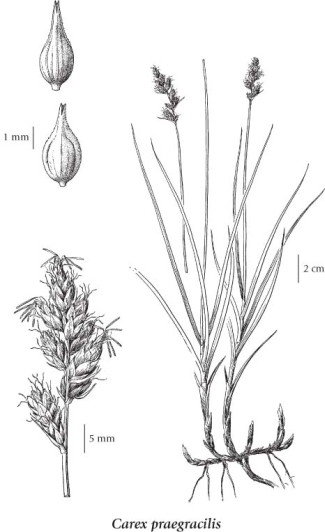Carex praegracilis W. Boott
field sedge (clustered field sedge)
Cyperaceae (Sedge family)
Introduction to Vascular Plants
field sedge (clustered field sedge)
Cyperaceae (Sedge family)
Introduction to Vascular Plants
Species Information click to expand contents
General:
Perennial herb from stout, creeping, dark rhizomes; stems 30-75 cm tall, arising singly or a few together, longer than the leaves.
Leaves:
Sheaths green, the lower ones bladeless, persisting, darkened; blades 2 to 5 per stem, crowded toward the base, flat or nearly so, 1-3 mm wide.
Flowers:
Spikes 6 to 15, clustered into a cylindrical or egg-shaped, 1- to 5-cm long head, the spikes 0.7-1 cm long, short-stalked, with both female and male flowers (sometimes with nearly all male flowers or nearly all female flowers), the male flowers towards the tips; bracts 1 to 3, up to 3 cm long, like the scales.
Fruits:
Perigynia egg-shaped to narrowly egg-shaped, 3-4 mm long, 1.3-1.5 mm wide, appressed-ascending, light to dark brown, biconvex, smooth, few- to several-nerved below, short-stalked, the beaks bidentate, finely-toothed, 0.6-1.3 mm long; female scales egg-shaped, as long as and slightly wider than the perigynia, awn-tipped, straw-coloured to light brown or rarely dark brown, the midribs pale, the margins translucent; stigmas 2; achenes lens-shaped, smooth, 1.2-1.7 mm long.
Illustration click to expand contents

If more than one illustration is available for a species (e.g., separate illustrations were provided for two subspecies) then links to the separate images will be provided below. Note that individual subspecies or varietal illustrations are not always available.
Illustration Source: The Illustrated Flora of British Columbia
USDA Species Characteristics click to expand contents
Flower Colour:
Green
Blooming Period:
Late Spring
Fruit/Seed characteristics:
Colour: Brown
Present over the Summer
Source: The USDA
Ecology click to expand contents
Ecological Framework for Carex praegracilis
The table below shows the species-specific information calculated from
original data (BEC database) provided by the BC Ministry of Forests and Range.
(Updated August, 2013)
The table below shows the species-specific information calculated from
original data (BEC database) provided by the BC Ministry of Forests and Range.
(Updated August, 2013)
| Site Information |
Value / Class |
||
|
Avg |
Min |
Max |
|
| Elevation
(metres) |
1018 | 39 | 2122 |
| Slope
Gradient (%) |
7 | 0 | 80 |
|
Aspect (degrees) |
190 | 0 | 356 |
| Soil
Moisture Regime (SMR) [0 - very xeric; 4 - mesic; 8 - hydric] |
5 | 0 | 8 |
| Modal
Nutrient Regime
Class |
D | ||
| #
of field plots species was recorded in: |
199 | ||
| Modal
BEC Zone Class |
IDF | ||
|
All BEC Zones (# of stations/zone) species was recorded in |
BG(15), CWH(20), ESSF(19), ICH(2), IDF(78), IMA(1), MH(1), MS(11), PP(5), SBPS(23), SBS(15), SWB(1) | ||
|
Source:
Klinkenberg 2013
|
|||
Habitat and Range click to expand contents
Moist to wet, often alkaline, meadows in the steppe and montane zones; common in SC and SE BC east of the Coast-Cascade Mountains, rare northward; N to AK and SW YT, E to S PQ and S to MA, PA, VA, KY, MO, OK, NM, AZ and CA.
Status Information click to expand contents
Synonyms click to expand contents
Synonyms and Alternate Names:
Carex camporum Mack.